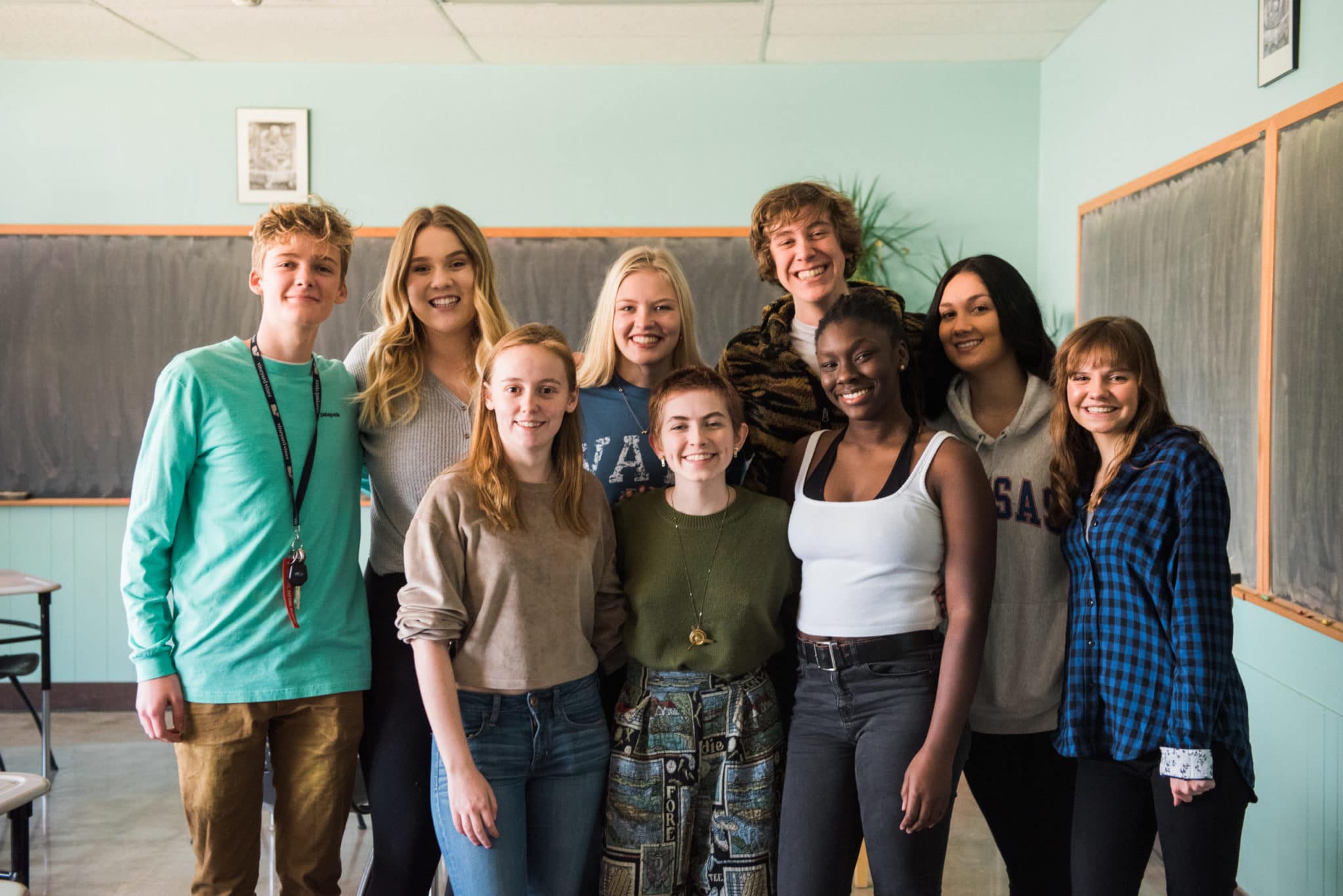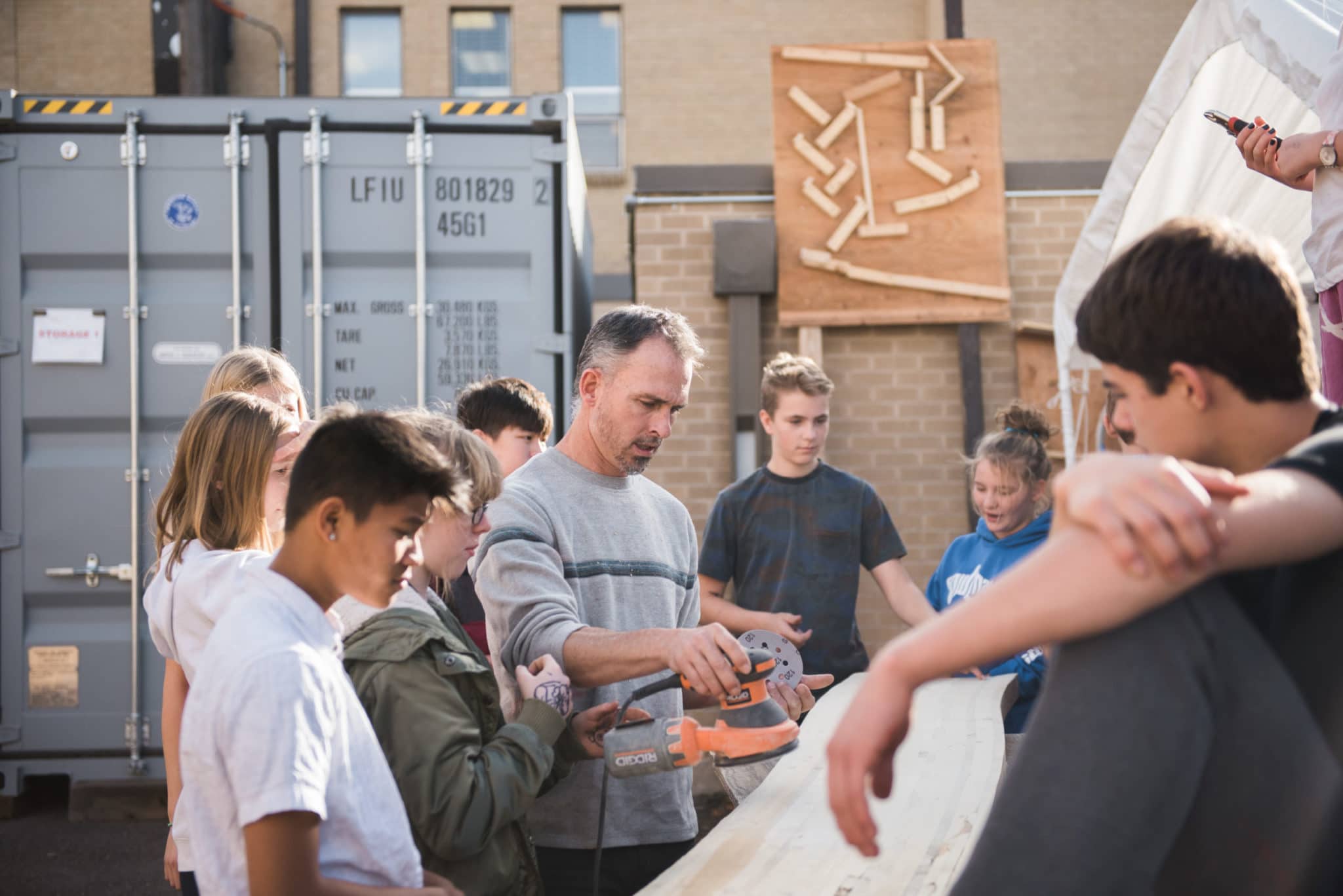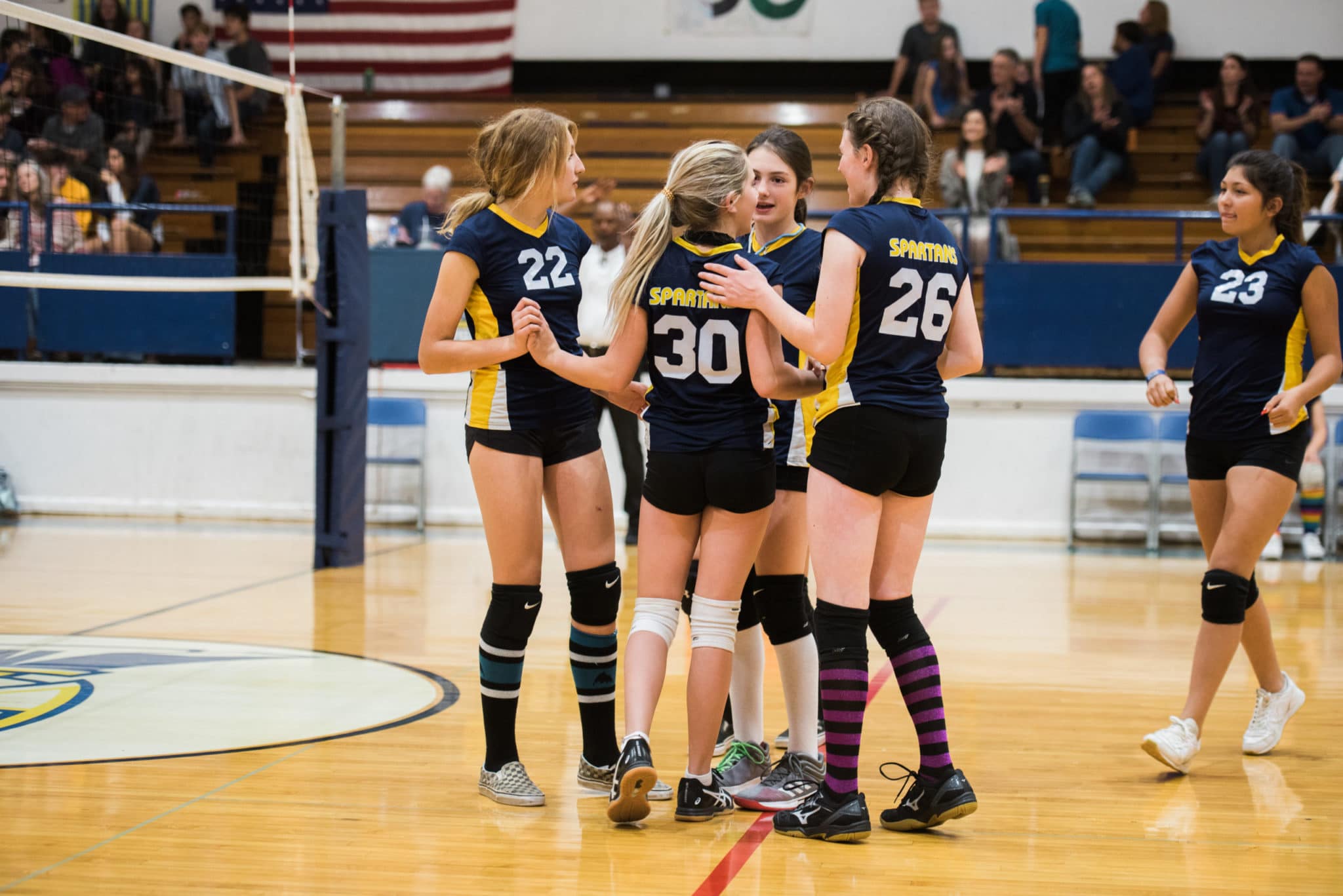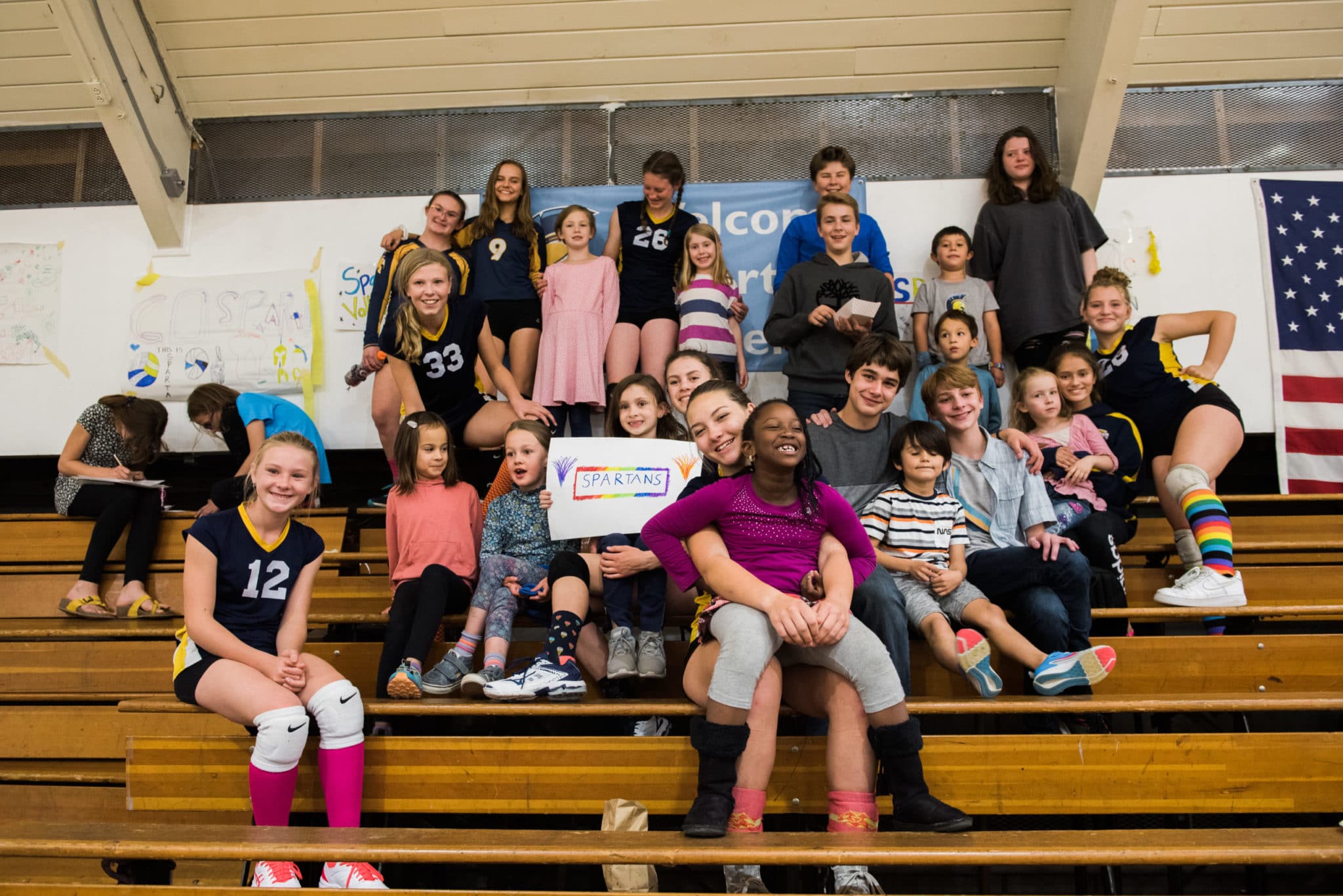Relaxing Time

A recent visit to the Waldorf forest kindergarten in Saratoga Springs, NY resonates in memory in a special way. The children whose parents have chosen this program have a consciously simplified environment freed of the temptations and distractions of the busier city life not far down the road. The group spends nearly the whole morning out in nature—no matter the weather–except perhaps for the first hour of morning in deepest winter when the air needs an hour to warm above super-frigid temperatures. Children are called upon to develop heartiness and resiliency in meeting the weather, terrain, practical tasks, and social experiences from which our society too often excessively shelters children. These are all important things for us to appreciate in how these experiences benefit the children’s development physically, emotionally, and socially. But we can take these points up at another time because it is something else that stands out so prominently in memory from this visit.
A young three-year old little girl new to the program latched on to my hand as the group of children began the walk along a trail into the woods. The pathway was made of rounded stepping stones; narrow, slightly-elevated boards to give us walking space above the soggy ground below; similar little “bridges” of two parallel boards that would bounce and spring slightly as we walked their length, challenging our balance; uneven ground that could not be avoided; and puddles that just had to be stepped in. We walked along slowly, three-year old legs having a short stride and some insecurity on the tippy rocks. She held my hand for balance until the path became too narrow and we had to walk single-file. Then she went on independently. We set no speed records. And no one minded. The thirty-two children and five adults walked along in little clusters, some faster, some slower. No one hurried the children along. Getting to our destination took as long as it needed. The littlest children were in no way made to feel inadequate or deficient because they could not walk fast or if a foot slipped on a wet rock and muddy, water-proof overalls resulted. Each child was respected for the capacities she had developed so far, knowing that new skills, competence, and confidence grow upon consolidation of what comes before.
But this still is not really the point. What speaks so strongly in memory is that the teachers allowed the children as much time as was needed to walk our little journey. Each child was allowed to do as much independently as she could, no matter how long it took. Expectations were released of how much or how fast things should happen. The day expected less accomplishment because it was so satisfying to complete a few things well.
The little girl moved on to join other children and did not seek my companionship again. She did not need it. She had literally found her feet and her standing with the other children. She had been granted the time to experience what she could accomplish on her own.
We want our children to become confident, independent doers and directors of their own lives. They can, but we adults have to give them the time to find their own strength. We do not need to speed them up but to slow ourselves down and let the children lead us. We will all benefit.
By Nancy Blanning (our learning specialist) as originally published in Lilipoh Magazine
Wisdom of Waldorf - The Value of Music
This week’s article was published in Psychology Today. At a time when music and art are considered unnecessary or tangential to an education that is designed to support these next generations in preparing for the future, the research presented in this article found evidence of positive relationships between school music participation and high school exam scores in English, mathematics, and science.
Rather than tangential, music has been and is an integral part of the Waldorf curriculum from pre-school through high school. Not because it’s presumed that every student will pursue it as a career, but for many of the reasons discovered in this research.
– Sandra Easter, PhD
Wisdom of Waldorf is shared weekly via our Facebook page, connect here to follow with more wisdom!
Welcoming Back our Alumni
Great communicators.
Problem solvers.
Good listeners.
Open-minded thinkers.
These are just a few of the traits unique to Waldorf graduates according to alumni from The Denver Waldorf School. To kick off the new year, we welcomed back a panel of our alumni and hosted a discussion featuring graduates from classes spanning 1995 to 2019.
The panel’s composition reflected the diverse interests and talents of Waldorf students—including a Ph.D. candidate in Chemical and Biological Engineering, a student pursuing a Master’s from The Juiliard School, an IT and software engineer, a Waldorf educator and coach, and college students studying subjects ranging from musical theater to chemical engineering to veterinarian medicine to psychology.
Although their individual journeys differ, the panelists pointed to their Waldorf education as an inspiring, confidence-building and mind-opening force in their lives. Waldorf pushed each of them to be “full people” through a diverse liberal arts curriculum, they suggested.
Through its core and elective courses, our school exposes students to disciplines in the arts, sciences, mathematics, literature and poetry, history, fine arts, practical arts, industrial arts, music, movement, world languages, theater and beyond. The graduates noted that this diversity of education endowed them with an appreciation for, not only their chosen profession or studies, but their peers’ paths as well.
In addition to crediting diverse fields of study with their citizen-of-the-world outlook, the graduates also identified Waldorf’s small class sizes as a strength that gave them the confidence to find their niches in the bigger world.
One graduate explained that he knew how to create strong bonds with his peers and teachers, and therefore he confidently headed into a much larger college. Another panelist noted that her college professor expressed her appreciation for Waldorf graduates in her classes for their ability to think critically and communicate effectively. The small size of Waldorf schools— with a focus on building strong relationships within the student body—prepared these students to thrive.
The students’ work outside the classroom also prepares Waldorf students to find their place in the broader society and contribute to their communities. Beginning in third grade, Waldorf classes experience annual overnight trips, sometimes to learn from Mother Nature’s goodness, sometimes to be in service to others.
Slowly but surely, the class trips move farther away from Denver, from Colorado, and even from the United States, and all the way to transformational senior trips to Australia, Costa Rica and Peru (to name a few). These trips build community, at home and abroad, and allow students to see themselves as citizens of the world.
With an education that celebrates tradition, provides a rhythm of thinking, feeling and willing, and encourages students to experience the curriculum deeply as tools with which they can build their lives- our alumni shine brightly in the broader world. We always feel grateful to welcome them back home to DWS and enjoy hearing of their journeys, seeing their lives in motion.

Members of the Class of 2019 gather with a couple old friends from the Class of 2020, sharing wisdom of their days beyond DWS!
Wisdom of Waldorf - The Benefits of Handwriting

This week’s article is about the benefits of handwriting.
Virginia Berninger, a professor emerita of education at the University of Washington, states that “when we write a letter of the alphabet, we form it component stroke by component stroke, and that process of production involves pathways in the brain that go near or through parts that manage emotion.”
Handwriting is integral to Waldorf education. Form drawing using hands, feet and the whole body is the first step in becoming familiar with the basic components of letters as well as the basic forms that are implicit in even the most complex geometric forms. This is not only pedagogically sound, it supports brain development.
https://elemental.medium.com/bring-back-handwriting-its-goo…
– Sandra Easter, PhD
Wisdom of Waldorf is shared weekly via our Facebook page, connect here to follow with more wisdom!
Denver Waldorf Teacher Spotlight - Nathan Ballenger

When students at The Denver Waldorf School are asked what they love about their education, they often comment that they treasure their close relationships with teachers. They are full of gratitude to be surrounded by caring, dedicated and inspiring teachers.
Our Teacher Spotlight series highlights a new teacher each month. This month, let’s get to know Nathan Ballenger.
What grades and subjects do you teach?
STEAM and Math: 6th grade through 8th grade.
Circus Club: 2nd grade through 8th grade.
What is your educational background?
I have a BS from Fort Lewis College in Durango, Colorado. I majored in Biology, minored in Chemistry and Psychology. I am also a Certified Energy Auditor.
What were the next stops on your journey prior to coming to The Denver Waldorf School?
I lived in India and traveled throughout the world before, during and after college. My travel and global community were deeply impactful of my journey. I have been to the home of the Dalai Lama, to the Old City of Jerusalem, to the jungles of the Quichua people in Ecuador and Peru, to the jungles of Chiapas and to Copper Canyon where the Tarahumara reside. I have hiked the Himalayas, the Andes and the Rockies. I traveled with a circus troupe in Ecuador doing acrobalance and clowning, as well as performed in circus on the streets of Delhi. All of these experiences have greatly contributed to who I am today.
My first job out of undergraduate school was as an air quality specialist for La Plata County in collaboration with the Colorado Air Pollution Control Division. I also sat on the Four Corners Ozone Task Force executive board, and worked directly with the Southern Ute Tribe emissions testing.
I then taught at Mancos Valley Independent School, a Waldorf school, as a 3rd grade co-teacher, Spanish teacher and games teacher.
I also owned and operated two companies- NRG By Design and Second Harvest Builders. NRG By Design provides services in energy efficiency auditing, analysis, design and construction. Second Harvest Builders is a custom home builder specializing in natural and alternative building techniques such as straw-bale construction, natural clay and lime plasters, reclaimed materials and conventional building practices.
Finally, I worked as a search-engine marketing consultant as well as at Tesla in solar design and consulting.
How many years have you taught at The Denver Waldorf School?
This will be my third year teaching, and my second year at The Denver Waldorf School. I also sat on the Mountain Phoenix Community School governing board for three years.
What drew you to the Waldorf curriculum?
I co-taught with Marian Barton at the Mancos Valley Independent School from 2004-2005. This experience influenced my entire parenting experience, and has been a part of my life ever since. My wife is a certified Waldorf teacher and Early Childhood Specialist. Waldorf curriculum and anthroposophy have been a big influence on my worldview for about 15 years.
What is your teaching philosophy and approach?
My number one goal is to generate enthusiasm and interest in all of my students for the subject matter, for learning and for life. This requires knowing each of my students individually, as well as knowing my class as a community. Each class is unique and requires different methods and creativity in the ways you approach teaching.
Middle school is a time when the children are beginning to look out into the world, in a way, for the first time. Prior to middle school, the children are focused inward, to their own self, their immediate community and family. In middle school, this shifts, and the children begin to look out toward their teachers, their peers and the world around them with interest and curiosity. This usually involves testing, trying things out, using different forms of communication etc. I try every day to pay special attention to what the children are seeking, asking for and excited about. This is ever-changing and shifts with the individuals and nature of the class.
As a teacher, my focus is to be flexible within that change, and to teach to the class in front of me at that moment. Not to teach to the class last week, or the class I think we should have. Middle school requires flexibility, creativity and an open mind. All of that said, I have an agenda including includes goals and expected outcomes. As the teacher, I show up well-prepared and ready to accomplish my goals with the class in order to prepare them for maximizing their own potential in academics and in life. I try to give them all the tools and experience I can muster while making sure they feel supported, loved and encouraged.
The Waldorf philosophy of education focuses on the whole child. What does this mean to you?
The whole child in short is the head, the heart and the hands. As a Waldorf teacher, we learn to understand what is developmentally appropriate for children in each phase and year of their growth and development. Teaching to the whole child means that learning involves a lot more than just memory. Not only do children learn differently as they grow, but each of them also learns differently through various methods of teaching. Experiencing the sensation of sawing wood with a fine-tooth saw and a large-tooth saw teaches a relationship with wood and tools in a way that words and pictures cannot reproduce. Some children learn well through hearing, some through seeing, some through experiencing and some through expressing.
Teaching the whole child means that we are using all of these methods with purpose. To teach to the whole child, I use multiple techniques, and I also pay special attention to what each child is going through and needing as they grow. Getting to know the students is learning about the whole child that I must teach to. This takes time, effort and mediation daily.
What makes The Denver Waldorf School unique?
The Denver Waldorf School is full of history. The faculty brings decades upon decades of experience. This rich soil of experience provides a deeply enriching environment for both students and new teachers who are fortunate enough to find their home at DWS. Our school is the product of this faculty experience as well as of many DWS families stretching back 45 years in the Denver area. I witness this wealth of history and experience in every faculty meeting, in the hallways we all pass through, and in the children who are impacted by it all. DWS is a special place because of the spirit of all who have been here and of all who are here today.

Pictured in the new STEAM classroom
Wisdom of Waldorf - The Importance of Breathing Out
This week’s article is about the way the “busyness” that is so characteristic of our modern culture affects our ability to be creative, and, our overall quality of life.
Stanford’s Emma Seppälä writes:
“The idea is to balance linear thinking—which requires intense focus—with creative thinking, which is borne out of idleness. Switching between the two modes seems to be the optimal way to do good, inventive work.”
Waldorf education, from pre-school through high school, recognizes this natural rhythm of breathing in and breathing out, of focused thinking and daydreaming, of intellectual rigor balanced with play. In this busy, demanding time of year, thought it might be worthwhile to bring attention to the value of breathing out.
~ Sandra Easter, PhD
Wisdom of Waldorf is shared weekly via our Facebook page, connect here to follow with more wisdom!
Wisdom of Waldorf - Impact of the Arts on Learning

This week’s post references a study that investigated the impact of the arts on learning. One of the questions and concerns many parents have about Waldorf education is the prominence of the arts. This recent research supports what’s been integral to the Waldorf pedagogy from its inception. The following quote sums it up.
“Arts learning experiences benefit students in terms of social, emotional, and academic outcomes,” write researchers Dan Bowen of Texas A&M and Brian Kisida of the University of Missouri.
Sandra Easter, PhD
Wisdom of Waldorf is shared weekly via our Facebook page, connect here to follow with more wisdom!
Denver Waldorf Teacher Spotlight - Dr. Wayne Mayer

When our students are asked what they love about their education at The Denver Waldorf School, one answer we hear frequently is that they treasure their close relationships with teachers. They are full of gratitude to be surrounded by caring, dedicated, and inspiring teachers. Our Teacher Spotlight series highlights a new teacher each month.
Let’s get to know Dr. Wayne Mayer below.
What grades and subjects do you teach?
I teach the high school’s Life Science courses along with two electives, including:
Human Anatomy – 9th Grade
Organic Chemistry (9th Grade)
Human Physiology (10th Grade)
Acids, Bases, and Salts (10th Grade)
Acids, Bases, and Salts Lab (10th Grade)
Atomic Chemistry (11th Grade)
Atomic Chemistry Lab (11th Grade)
Botany (11th Grade)
Embryology (11th Grade)
Human Sexuality (11th Grade)
Biochemistry (12th Grade)
Planet Earth (12th Grade)
Zoology (12th Grade)
The Science of Simple Tools – elective
The Culture of Peru Through Food – elective
What is your educational background?
PhD, December 2006 Environmental Science & Policy Duke University, Durham, NC
Graduate Certificates: International Development Policy; Latin American and Caribbean Studies
MS, June 1994 Forestry & Ecology University of Washington, Seattle, WA
BA, June 1991 Environmental Science, cum laude, University of Denver, Denver, CO
Double Minors: Anthropology; English Literature
What was the next stop (or stops) in your journey before coming to The Denver Waldorf School?
I lived in Latin America where I worked as an educator, a journalist, a conservationist, a research scientist, and a sustainability and sustainable development consultant.
As a consultant, I led a wide range of clients in situations that were often complex, technical, contentious, multi-disciplinary, and involved varying numbers of people from small focus groups to large strategy summits. I guided clients to transform “Us vs Them” dynamics into “All of Us” alliances.
How many years have you taught at The Denver Waldorf School?
This is my first-year teaching at The Denver Waldorf School, but I have been teaching at the university level for over 25 years. From 1996 to 1998, I served as the Academic Director for the School for International Training (SIT) College Semester Abroad Program in Venezuela. Currently, I hold visiting faculty appointments at both the University of Denver and Duke University.
What drew you to the Waldorf curriculum?
I like the integrated, holistic approach to teaching and learning.
What is your teaching philosophy and approach?
The best learning—whether through formal and rigorous academics or informal and playful dialogue—occurs through what I call “fun with a purpose.” As the former Academic Director for the School for International Training’s College Semester Abroad Program in Venezuela, I know that communication through stories proves useful in field-based teaching and in communicating the concepts of biological conservation to communities and project participants. For example, if a student is listening to a story and is enthralled and laughing and then, suddenly, she realizes that this story is about the reproductive biology of a palm species or the mating habits of an endangered tree frog, she’ll likely think that learning about nature and science shouldn’t be this much fun. I aim for that reaction. I also strive to inspire students to ask the overarching questions: Why is that? Why does this matter? I address these questions at the onset of a block; then, throughout the course, I do my best to express my own excitement and interest in the subject at hand. Together, my students and I search for answers. In doing so, I hope to teach and to learn more about both the wonder of nature and the urgent need to conserve it.
The Waldorf philosophy of education focuses on the whole child. What does this mean to you?
Teaching the whole child means tapping into the student’s internal inspiration—understanding what motivates that child—and teaching and learning through an integrated combination of social, emotional, and academic connections. This triangulation of head, heart, hands or mind, body, spirit, means bringing art, nature and movement into the attraction, appeal and relevancy of learning.
What makes The Denver Waldorf School unique?
The enthusiastic teachers and administrators make The Denver Waldorf School a one-of-a-kind place to teach and learn.

Dr. Wayne Mayer pictured with students building a Rube Goldberg machine during the elective of “The Science of Simple Tools”.
Why We Play - Community & Growth through Sports

In her inspiring book, Norwich: One Tiny Vermont Town’s Secret to Happiness and Excellence, Karen Krouse sets out to answer a simple question: how has one small town in Vermont produced so many resilient, confident, and happy Olympic-level athletes?
The answer may surprise you. It’s not by pushing kids to train harder at a young age; it’s not about embracing hyper-competitiveness; it’s not about making kids specialize in a single sport. Rather, it’s about making sports a fun, communal experience. Krouse explains, “the parents of Norwich learned through trial and error the best methods of nourishing happy athletes: by valuing participation and sportsmanship, stressing fun, community, and self-improvement.”
In many ways, Waldorf education embraces the wisdom set forth in Norwich. Molding an elite athlete is not the end goal; rather, it is a byproduct of a healthy relationship to sports and movement. Beyond just winning, development of character is the emphasized result in the athletic arena.
Whether it’s a young student working on balance and coordination through Circus Club, a middle school student learning the value of teamwork on the volleyball court, or a high school athlete flying down the Ultimate Frisbee field, the Denver Waldorf School promotes community, growth, and sportsmanship through athletics. There are no tryouts or cuts. Instead, each athlete is inspired to reach their highest potential, contributing to the team through enthusiasm, hard work, grace, and resilience. Every athlete has their place on our teams.
These lessons begin early on. For example, the first graders recently attended a volleyball game to cheer on their eighth grade buddies. With impressionable eyes upon them, the eighth graders displayed poise, confidence, and grace on the volleyball court. The athletes came together in a circle, connected with their arms around each other, after a tough point — won or lost.
On the court, they supported each other, worked together, and afterwards found their first grade buddies. In a word, they built community—the kind of community where young athletes can flourish and grow.

Holding the Question

“Holding the question.” It’s a phrase you may hear from a Waldorf teacher. But what does this mean?
It’s about waiting to answer the question: who is this person? We ask and answer this question all the time — when we meet a new friend, when we meet a teacher, and when we gather as a family. We are constantly scanning the world around us and answering the question: who are all these people in and around my life?
In Waldorf schools, “holding the question” is especially important because the same main lesson teacher stays with a group of students from 1st through 8th grade. It’s tempting for that teacher to answer the question — “who is this student of mine?” — in the first few weeks of first grade.
The concern is, when a teacher answers the question “who is this person” too soon, that teacher limits the student-teacher relationship. Once defined, it’s difficult for the child to shake his or her label, and it’s difficult for the teacher to see that child with fresh eyes.
And that’s why the idea of holding the question is so important. It’s about allowing the child to show his parents, his teachers, his family, and his friends exactly who he is becoming, slowly and over time. It’s about being patient and resisting the urge — however well-intentioned — to define a child too soon.
We know that the temptation to answer the question is strong. We want to know: who is this precious child of ours? What makes him tick? Who will she grow into? All of our hopes and dreams are mashed up into this one question: who are you?
But, perhaps, we can give our children a great gift: holding the question. Perhaps we can let them show us who they are. Perhaps we can give them the space needed to emerge as their own unique individuals. We can enjoy and celebrate them for who they are today, and love them unconditionally as we journey alongside them.
Take an activity like watercolor painting. One young child may quickly spread all of the colors available at one time, watching them blend together as one. Another may pick one color at a time, slowly watching the colors interact and dance.
But what does that say about our kids? Does it have to say anything? We try to hold the question. They are both expressing themselves in their own ways. Their means of expression may change over time, but we hope their curiosity remains. We don’t want to define their artwork and unwittingly limit who we see them as and what they can become.
In a way, our children are the artists of their own lives. We can’t predict what they’ll paint. We’ll let them create something beautiful. And we’ll be there to share in the joy of their own unique journeys.


